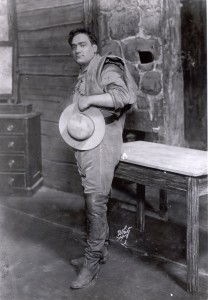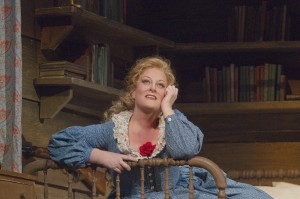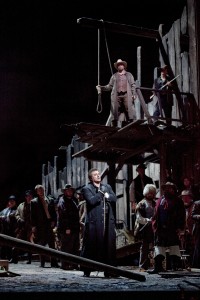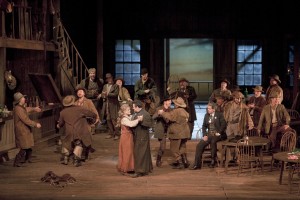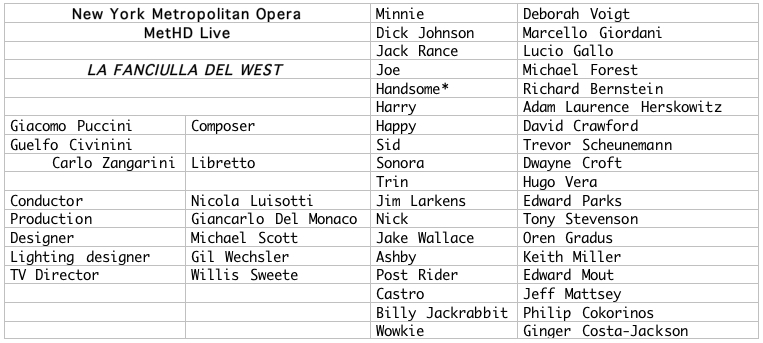In 1907 Giacomo Puccini was in New York for the American Premiere of his latest opera Madama Butterfly. While there he saw David Belasco’s play, The Girl of the Golden West, and remarked, “That is my next opera.”
Three years later on December 10, 1910 Giacomo Puccini was in the audience at the “Old Met” to hear Arturo Toscanini conduct the World Premiere of La Fanciulla del West starring Enrico Caruso. Talk about name-dropping!
Yesterday, January 8, 2011, I was in the audience at the Palo Alto Square Cin�Arts theatre to see Nicola Luisotti”�”� conduct the MetHD performance of La Fanciulla del West starring “Deborah Voigt in the title role of Minnie in Giancarlo Del Monaco’s 1991 production, with Marcello Giordani as Dick Johnson (the disguised bandit Ramerrez) and Lucio Gallo as the villainous sheriff Jack Rance.”
Among the many benefits of the MetHD productions are the back-stage interviews during the intermissions. I first knew I was going to like GGW during the intermission of Don Carlos a month earlier. Deborah Voigt was hostess for Don Carlos and she interviewed Marcello Giordani about that next production, asking him, “What is your favorite part of that opera?” “That’s an easy question,” he said, grabbing her and bending her backwards in a passionate kiss.
GGW, like many grand operas has three principal characters: a hero, a heroine, and a villain. But they are not your typical H, H, and V. For one thing, they are all alive at the final curtain! But more important, all three are complex characters. Take Minnie, for example. In Act I she is all a heroine should be: pure, virtuous, and good. A bit stronger than average, but without a base thought in her pretty head. The men all love and respect her.
But in Act II she cheats at cards – and one of the tiny subplots of Act I shows that the men regard cheating at cards as only infinitesimally less heinous than murder.
Likewise, aside from stupidity and placing his “honor” far above his passionately declared love, your typical opera hero is an embodiment of all masculine virtues. But Dick Johnson makes his living as the bandit Ramerrez, robbing rich and poor for his personal well-being. Even if you believe his statement that he never murdered anyone, he was chief of the gang, someone in the gang pulled the triggers, and Dick profited from the murders. Further, at the end when he is captured and about to be hung, he says nothing about honor but exhibits some honorable behavior by saying, “As my dying wish, don’t let Minnie know how I died. Tell her I escaped and am going far, far away to start a new and better life.”
The quoted blurb in the second paragraph calls Jack Rance “villainous”, but is he? After all, he is sheriff and he wants to catch and hang a notorious bandit. OK, so he lusts after Minnie, but he wants to force her into marriage, not the one-night rape that Scarpia dreams of or the evil machinations of Iago.
If I were a strict Law-and-Order guy, I would have to rail against this plot where justice is thwarted while robbery and cheating are rewarded. But the skill of Puccini and his librettists – and of the performers on stage – makes all of his characters human, rather than hero or villain. The live audience at Lincoln Center and all of us at Cin�Arts rejoiced when Minnie and Dick find happiness at the end and even Jack accepts his defeat without obvious bitterness.
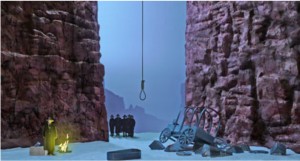
Opening scene of Act III from SF Opera production of Fanciulla; Photo: model courtesy of San Francisco Opera
Last June I attended and reviewed San Francisco Opera’s production of The Girl of the Golden West, and wrote a rave review Girl of the Golden West Review – Reactions to Puccini’s “Oater”. I’ve just reread that review, and I won’t take back a single word. But the MetHD performance was even better.
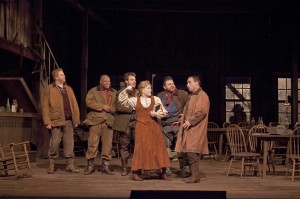
Minnie with a group of miners: Adam Laurence Herskowitz as Harry, Michael Forest as Joe, David Crawford as Happy, Hugo Vera as Trin, and Richard Bernstein as Bello
Of course, there’s no comparing the lead, since Deborah Voigt shone as Minnie in both productions. And there is a certain thrill to being present at a live performance by a star whose name is known to all opera-lovers and whom I’ve seen countless times on TV or in movie theaters. But all in all, seeing her on HD was even more satisfying, because the close up views showed what an expressive face she has. I’ve no idea how many birthdays Ms V has enjoyed, but it’s clearly been many years since she was “Sweet Sixteen and . . .” But the look on her face, particularly the expression in her eyes, when she catches her breath afterward made it easy to believe that the kiss from Signor G was indeed Minnie’s First Kiss.

Opening scene of Act I from SF Opera production of Fanciulla Photo: model courtesy of San Francisco Opera
The outstanding difference between the two productions was the realism of the Met production compared with the special effects of the SF Opera. At the time I was impressed by the opening tableau at SF – miners rappelling down a stage-high vertical cliff. The Met offered nothing comparable; the opening curtain went up on the Polka Saloon. But as I think about it now, I realize that the rappelling was a gimmick; it added nothing to the story.
Both productions used live horses on stage; in fact one of the Met interviews was with the small outfit whose business was furnishing live animals for theatrical productions. But here, too, the Met was more subdued. When it was appropriate for a character to come from somewhere else, he appeared on a horse, rode up to the saloon or Minnie’s house, and dismounted. As he entered the building, a servant would lead the horse off stage. At SF in the final scene Minnie herself makes a dramatic entrance on horseback in the nick of time to save her lover from a hanging.
For the final curtain on HD, the miners walk off stage to go about their business; Minnie and Dick walk off on their way to a far away place to start life anew; only Rance is left on stage. He takes his gun out and looks in the direction they have gone. But he holsters it without ever raising it and turns to the audience with a rueful smile on his face as the lights dim and the curtain falls. In SF, Minnie’s horse is hitched to a carriage, the couples climb in and the carriage drives off into the sunset.

Closing scene of Act III from SF Opera production of Fanciulla; Photo: model courtesy of San Francisco Opera
Inevitably, Puccini’s opera has been called an “oater”. I would sum up the Met production as pure grade A oats. The SF production was served up with a substantial portion of corn. But I’ll take any opportunity I can to see either of them again. As a matter of fact, I plan to go to the MetHD Encore performance at 6:30 pm on Wednesday January 26. Care to join me at your local theater?
The Opera Nut
Photos: Except where otherwise specified photos are by Ken Howard/Metropolitan Opera
This review by Philip G Hodge appeared in sanfranciscosplash.com on Jan 14, 2011

